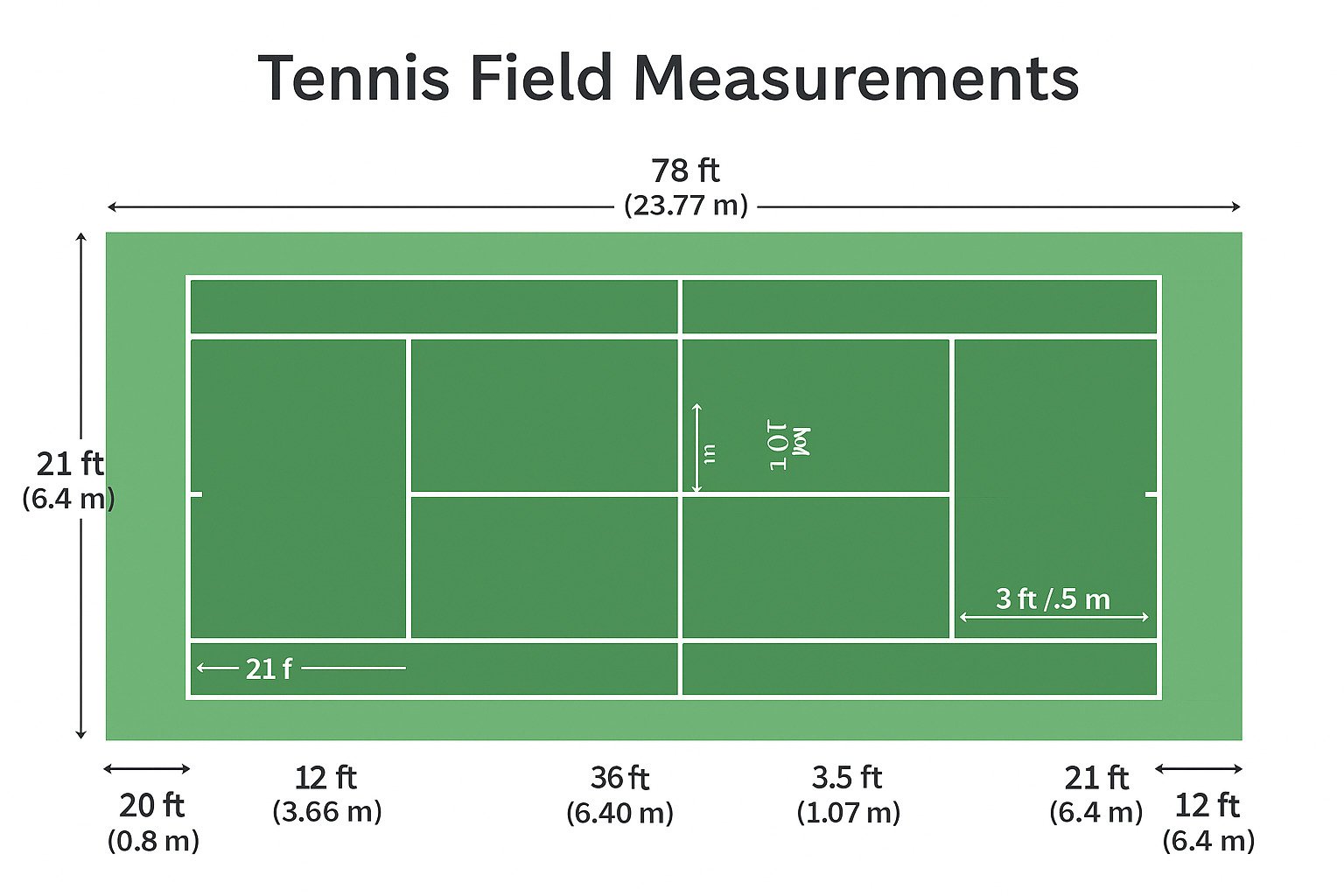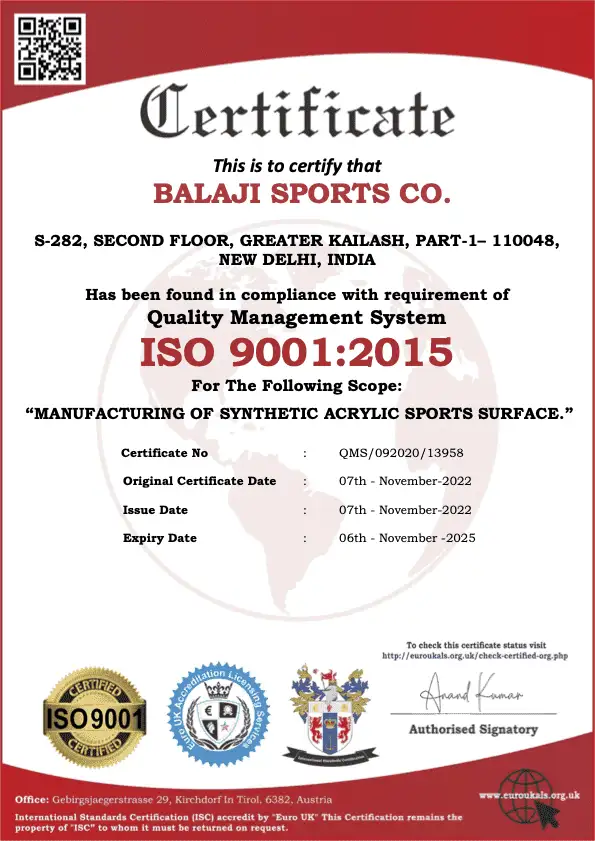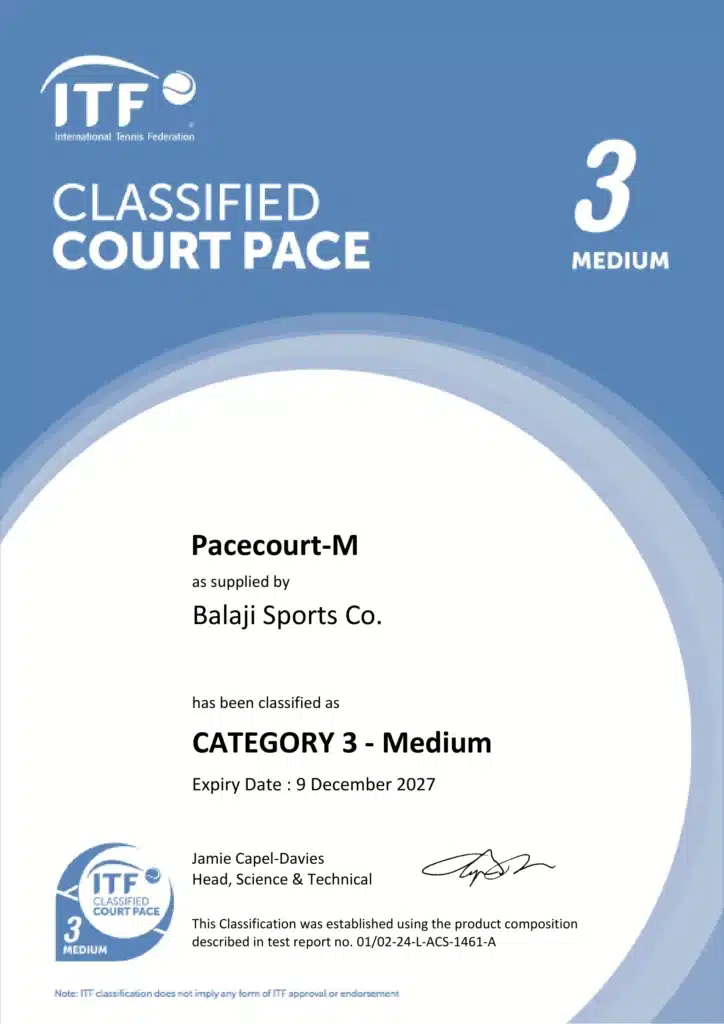
A perfectly measured tennis court is the foundation of every great match — from local tournaments to international championships. Understanding tennis field measurements is essential for players, coaches, and court builders who aim to maintain professional standards. According to the International Tennis Federation (ITF), tennis court dimensions must be precise to ensure fairness, safety, and consistent gameplay across all surfaces — whether acrylic, clay, or grass.
In this guide, we’ll break down the standard tennis court dimensions in feet and meters, including court length, width, service boxes, net height, and surrounding space. Whether you’re building a new tennis court or just curious about the layout, this article will help you understand every measurement that defines a regulation tennis field.
Standard Tennis Court Dimensions
A standard tennis court is designed according to precise measurements defined by the International Tennis Federation (ITF) to ensure uniformity across the world. Whether you’re playing a casual match or competing professionally, the court dimensions remain the same — only the width changes between singles and doubles play.
Tennis Court Size in Feet and Meters
- Length: 78 feet (23.77 meters)
- Width for Singles: 27 feet (8.23 meters)
- Width for Doubles: 36 feet (10.97 meters)
This means that the total playing area is slightly wider for doubles matches to allow more space for team play.
Additional Measurement Details
- Service Line: Positioned 21 feet (6.4 meters) from the net on both sides.
- Net Height at Posts: 3.5 feet (1.07 meters)
- Net Height at Center: 3 feet (0.914 meters)
The center mark divides the baseline in half and helps players position themselves accurately while serving.
Total Area Including Runoff Space
While the playing area is fixed, a minimum clear space around the court is essential for safety and free movement:
- Behind each baseline: 21 feet (6.4 meters)
- On each side: 12 feet (3.66 meters)
This makes the total area of a standard tennis court approximately 120 feet (36.58 meters) long and 60 feet (18.29 meters) wide, including the run-off zones.
✅ Key Takeaway
The standard tennis court dimensions ensure consistency, allowing players to adapt their skills easily on any certified court worldwide. Whether built for clubs, schools, or residential projects, following ITF-approved measurements guarantees a professional-quality playing experience.
Service Boxes and Baseline Markings
When it comes to tennis court layout, two of the most important components are the service boxes and baseline markings. These lines define the key playing zones where serves must land and where players position themselves during rallies. Understanding their exact measurements is crucial for maintaining an accurate and professional tennis field setup.
🎯 Service Boxes Dimensions
A standard tennis court has two equal service boxes on each side of the net, divided by the center service line. These boxes determine where a serve must land to be considered valid.
- Distance from net to service line: 21 feet (6.4 meters)
- Width of each service box: 13.5 feet (4.11 meters)
- Total width across both boxes: 27 feet (8.23 meters) — the same as the singles court width
The center service line and center mark help players position their serves accurately, ensuring fair play on both sides.
🟨 Baseline and Center Mark
The baseline runs parallel to the net and marks the farthest boundary at the back of the court.
- Players must stand behind the baseline while serving.
- The center mark, a small 4-inch (10 cm) line in the middle of the baseline, divides it into two equal halves.
- It helps servers identify the correct serving side — deuce court (right) and advantage court (left).
📐 Purpose and Importance
The precise alignment of service boxes and baselines ensures that every serve, rally, and point is judged accurately according to ITF tennis court standards. Even a small deviation in these measurements can affect gameplay and fairness, especially in professional matches.
Net Height and Placement

The tennis net is one of the most critical elements of a court’s design, serving as the central barrier that defines each side of the playing field. Maintaining the correct net height and placement ensures fairness, consistency, and compliance with ITF tennis court standards.
🎾 Standard Net Height Measurements
According to the International Tennis Federation (ITF), the official tennis net height varies slightly between the posts and the center:
- Height at Net Posts: 3.5 feet (1.07 meters)
- Height at Center: 3 feet (0.914 meters)
This gentle downward curve is intentional — it ensures proper tension, allowing the ball to pass over the net realistically while maintaining uniform bounce behavior during play.
📏 Net Placement and Length
The tennis net runs across the full width of the court, extending slightly beyond the sidelines for stability:
- Total Length: 42 feet (12.8 meters)
- Attached to posts placed 3 feet (0.914 meters) outside each doubles sideline.
Even on singles courts, the net posts remain in the same position, but singles sticks are used to narrow the playing width to 33 feet (10.06 meters), aligning with the singles court boundaries.
⚙️ Net Material and Tension
A regulation tennis net is typically made from braided nylon or polyethylene mesh. Proper tensioning is vital — too tight, and the ball rebounds excessively; too loose, and the ball may sag or fall through. The center strap ensures consistent height and stability during matches.
✅ Why Correct Net Height Matters
Maintaining the correct net height is essential for:
- Ensuring fair and accurate gameplay
- Preventing unfair net cord advantages
- Meeting professional tournament standards
Consistent net height and placement guarantee that the court performs the same way across all levels — from recreational to professional matches.
Surrounding Areas (Runoff Space)
When constructing a tennis court, it’s not just the playing surface that matters — the surrounding areas, also known as runoff space, play a major role in player safety, comfort, and overall game experience. Adequate runoff space ensures players can move freely and chase shots without the risk of injury or collisions with fences or walls.
🟩 Recommended Runoff Space Measurements
According to ITF tennis court standards, a regulation tennis court must include clear space around the playing lines:
- Behind each baseline: Minimum 21 feet (6.4 meters)
- On each side of the court: Minimum 12 feet (3.66 meters)
This means the total area required for a full-sized tennis court, including runoff space, is approximately:
- Length: 120 feet (36.58 meters)
- Width: 60 feet (18.29 meters)
These measurements create enough room for safe player movement and proper ball clearance, which are essential during competitive matches.
⚙️ Importance of Runoff Space
The runoff area isn’t just for safety — it also affects gameplay quality and spectator experience.
- Safety: Prevents injuries during fast-paced rallies.
- Visibility: Provides clear sightlines for umpires and line judges.
- Comfort: Allows players to recover and reposition easily between points.
🧱 Additional Considerations for Construction
- Ensure a flat, non-slip surface around the court perimeter.
- Leave extra space for fencing, benches, or umpire chairs.
- For indoor tennis courts, maintain proper lighting clearance and wall distance according to venue standards.
✅ Why Runoff Space Matters
Ignoring runoff space can lead to unsafe court conditions, especially in professional or high-speed play. By following ITF-approved tennis court layout standards, you can guarantee optimal performance, safety, and long-term durability of your facility.
Tennis Court Layout for Different Levels

While the standard tennis court dimensions remain consistent globally, the layout and size can vary depending on the level of play — from professional tournaments to school or junior matches. Understanding these variations helps builders and players design courts that suit different skill levels and age groups while still maintaining ITF tennis court standards.
Professional Tennis Courts (ITF & ATP/WTA Standards)
Professional courts follow strict International Tennis Federation (ITF) regulations to ensure uniformity and fairness across all competitions.
- Court Size: 78 ft × 36 ft (23.77 m × 10.97 m) including doubles alleys
- Runoff Area: 21 ft (6.4 m) behind baselines and 12 ft (3.66 m) on the sides
- Surface Options: Hard (synthetic acrylic), clay, or grass
- Usage: International tournaments like Wimbledon, US Open, and Australian Open
These courts are designed for high-speed play, strong footing, and maximum safety.
School and Recreational Tennis Courts
For schools, clubs, and community sports complexes, courts are often designed with a balance between standard measurements and space optimization.
- Court Size: Same as standard, but runoff space may be reduced to fit multiple courts in one area
- Surface: Synthetic acrylic or asphalt for durability and low maintenance
- Features: Simplified fencing and lighting setup
These layouts are ideal for training, local tournaments, and amateur players.
Mini Tennis Courts (10 & Under Tennis)
To make tennis more accessible for children, smaller courts — known as mini or junior tennis courts — are recommended by the ITF’s “Tennis10s” program.
- Red Stage (Ages 4–8): 36 ft × 18 ft (10.97 m × 5.49 m)
- Orange Stage (Ages 8–10): 60 ft × 21 ft (18.29 m × 6.4 m)
- Green Stage (Ages 9–10+): Full-size court (78 ft × 27 ft) with lower-compression balls
These modified dimensions help young players develop proper technique and confidence before transitioning to a full-sized court.
Indoor vs. Outdoor Tennis Court Layouts
- Indoor Courts: Require additional height clearance (minimum 30 ft / 9.14 m), proper ventilation, and lighting setup.
- Outdoor Courts: Designed with UV-resistant surfaces, drainage slopes (1:100 ratio), and fencing to prevent ball loss.
Both types maintain the same playing dimensions but adapt the surroundings for environment and playability.
Surface Types and Their Impact on Layout

The surface type of a tennis court not only affects the speed and bounce of the ball but also plays a key role in the overall court layout, maintenance, and player performance. While the dimensions of a tennis court remain the same across all surfaces, the surface material influences line marking methods, construction layers, and long-term durability.
🎾 1. Hard Courts (Acrylic or Synthetic Surfaces)
Hard courts are among the most popular surfaces used globally — especially in professional tournaments like the US Open and Australian Open.
- Material: Layers of acrylic or synthetic coatings applied over asphalt or concrete
- Bounce: Medium to fast
- Maintenance: Low; requires regular cleaning and line repainting
- Impact on Layout:
- Lines are permanently painted and sealed
- Surface slope (1:100) is included for water drainage
- Perfect for outdoor and indoor setups
These surfaces are ideal for consistent ball behavior and long-term durability, making them suitable for schools, clubs, and sports complexes.
🌱 2. Grass Courts
Grass courts are the oldest and most traditional type of tennis surface, used famously at Wimbledon.
- Material: Natural grass grown over a well-drained soil base
- Bounce: Fast and low
- Maintenance: High; requires mowing, rolling, and watering
- Impact on Layout:
- Needs proper underground irrigation and leveling
- Markings are done using non-toxic white paint
- Sensitive to weather changes
Grass courts provide a smooth, elegant playing experience but demand consistent upkeep.
🧱 3. Clay Courts
Clay courts are preferred in Europe and South America and are commonly seen in tournaments like the French Open (Roland Garros).
- Material: Crushed brick, stone, or shale
- Bounce: Slower with higher ball spin
- Maintenance: Medium to high; daily sweeping and regular resurfacing required
- Impact on Layout:
- Lines are typically made of plastic or fabric strips laid into the clay
- Proper water management and compaction are essential
- Offers excellent player comfort with reduced joint stress
Clay courts demand careful construction but are favored for training and long rallies.
🏗️ 4. Synthetic Turf Courts
Synthetic turf is a modern alternative that combines the look of grass with easier maintenance.
- Material: Artificial grass filled with sand or rubber granules
- Bounce: Medium speed
- Maintenance: Low; occasional brushing and cleaning
- Impact on Layout:
- Installed over an asphalt or concrete base
- Painted or inlaid line markings
- Suitable for multi-sport areas
These courts are popular in schools and recreational facilities for their versatility and durability.
Common Mistakes in Tennis Court Construction
Building a tennis court requires precision, experience, and adherence to ITF-approved standards. Even a minor construction error can affect performance, durability, and player safety. Many projects fail not because of poor materials but due to inaccurate measurements, poor drainage, or improper surface installation. Below are the most common mistakes to avoid during tennis court construction.
⚙️ 1. Incorrect Court Dimensions
One of the most frequent errors is using non-regulation measurements. A professional tennis court must be 78 feet long and 27 feet wide for singles or 36 feet wide for doubles, with adequate runoff space. Even a few inches off can impact gameplay and make the court unfit for tournaments.
✅ Solution: Always follow ITF tennis court dimension guidelines and verify with a certified installer before marking or surfacing.
💧 2. Poor Drainage Planning
A court with inadequate drainage will accumulate water, leading to surface damage and slippery conditions. This problem is common in outdoor courts, especially in areas with heavy rainfall.
✅ Solution: Design a 1:100 slope ratio for water runoff and use proper sub-base materials like crushed stone for efficient drainage.
🧱 3. Improper Base Construction
The base layer is the foundation of any tennis court. Using uneven or unstable materials can cause cracks, dips, or surface separation over time.
✅ Solution: Ensure a well-compacted, leveled base made from asphalt or concrete before applying the synthetic or acrylic surface coating.
🧭 4. Wrong Court Orientation
The orientation of the court affects visibility and playability, especially outdoors. Courts facing east–west cause players to look directly into the sun during morning or evening matches.
✅ Solution: Align the court north–south to minimize sun glare and ensure balanced lighting throughout the day.
🎨 5. Poor Line Marking or Paint Quality
Incorrect line placement or the use of low-quality paint can fade markings quickly and confuse players.
✅ Solution: Use UV-resistant acrylic paints and ensure markings follow ITF-specified measurements for service boxes, baselines, and center lines.
🧩 6. Ignoring Surface Type Compatibility
Each tennis surface type (clay, grass, hard, or synthetic) requires specific installation methods. Using the wrong materials or layering process can lead to premature surface wear.
✅ Solution: Choose the right surface system and ensure proper curing and coating thickness according to manufacturer guidelines.
🔧 7. Lack of Maintenance Planning
Even well-built courts deteriorate without regular upkeep. Cracks, faded lines, and surface roughness can quickly appear if not maintained properly.
✅ Solution: Implement a maintenance schedule for cleaning, repainting, and resurfacing every 4–6 years, depending on usage.
Maintenance Tips for Line Markings
Line markings on a tennis court play a vital role in defining the boundaries, service boxes, and baselines that guide every match. Over time, exposure to sunlight, moisture, and regular gameplay can cause these lines to fade or wear off. Proper maintenance of line markings not only keeps the court looking professional but also ensures accurate gameplay and compliance with ITF tennis court standards.
🎨 1. Use High-Quality Paint
Always use acrylic-based, UV-resistant paint specifically formulated for sports courts. Ordinary paints may fade, chip, or peel quickly under harsh weather conditions.
✅ Tip: Choose white or bright contrasting colors that remain visible against the surface type (green, blue, or red).
🧹 2. Clean the Surface Regularly
Dirt, dust, and algae can make court lines appear dull and uneven. Regular cleaning helps maintain visibility and paint longevity.
✅ Tip: Use a soft broom or pressure washer (on low setting) every few weeks to remove debris and prevent buildup.
🧴 3. Repaint Lines Periodically
Even high-quality paint wears down over time due to foot traffic and UV exposure.
✅ Tip: Repaint all lines every 12 to 24 months, depending on court usage and weather exposure. Always follow the original ITF-approved layout when repainting.
⚙️ 4. Inspect for Cracks Before Painting
Painting over cracks or uneven areas can lead to distorted lines and premature fading.
✅ Tip: Repair cracks with an acrylic resurfacer or patch binder before applying new paint layers.
🧱 5. Maintain Proper Drainage and Slope
Standing water accelerates paint deterioration and can cause peeling or discoloration.
✅ Tip: Ensure the court maintains its 1:100 slope ratio for proper water runoff, and inspect drains regularly to avoid puddles near lines.
🕒 6. Schedule Seasonal Maintenance
Depending on the climate, seasonal maintenance can prevent long-term damage.
✅ Tip: In hot climates, repaint lines at the start of summer; in humid areas, clean and treat surfaces before monsoon or winter seasons.
Conclusion
Building or maintaining a tennis court isn’t just about creating a flat surface — it’s about ensuring every detail, from court measurements to line markings, meets the International Tennis Federation (ITF) standards. Accurate tennis field measurements guarantee fairness, consistency, and safety for players at every level, whether it’s a professional tournament, a school facility, or a private court.
From understanding the standard tennis court dimensions to maintaining correct net height, surface type, and runoff space, precision is key. Even small deviations can affect gameplay and durability. Regular maintenance, proper surface selection, and adherence to professional guidelines help preserve the court’s quality and performance over time.
If you’re planning to construct or renovate a tennis court, it’s essential to partner with a trusted manufacturer who understands ITF standards and uses premium materials. Companies like Pacecourt specialize in synthetic acrylic tennis court surfaces that meet global specifications, ensuring superior durability, grip, and aesthetics.



